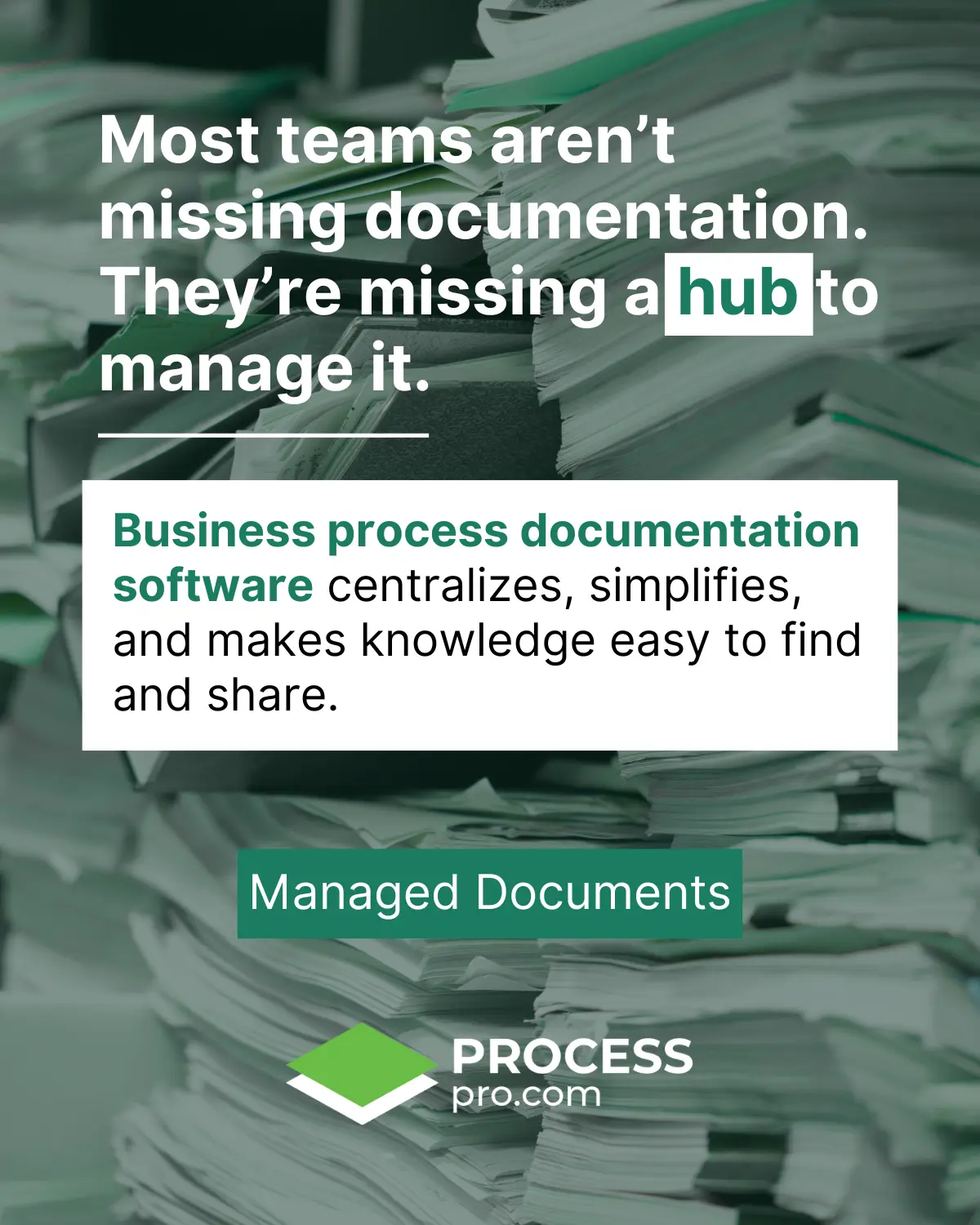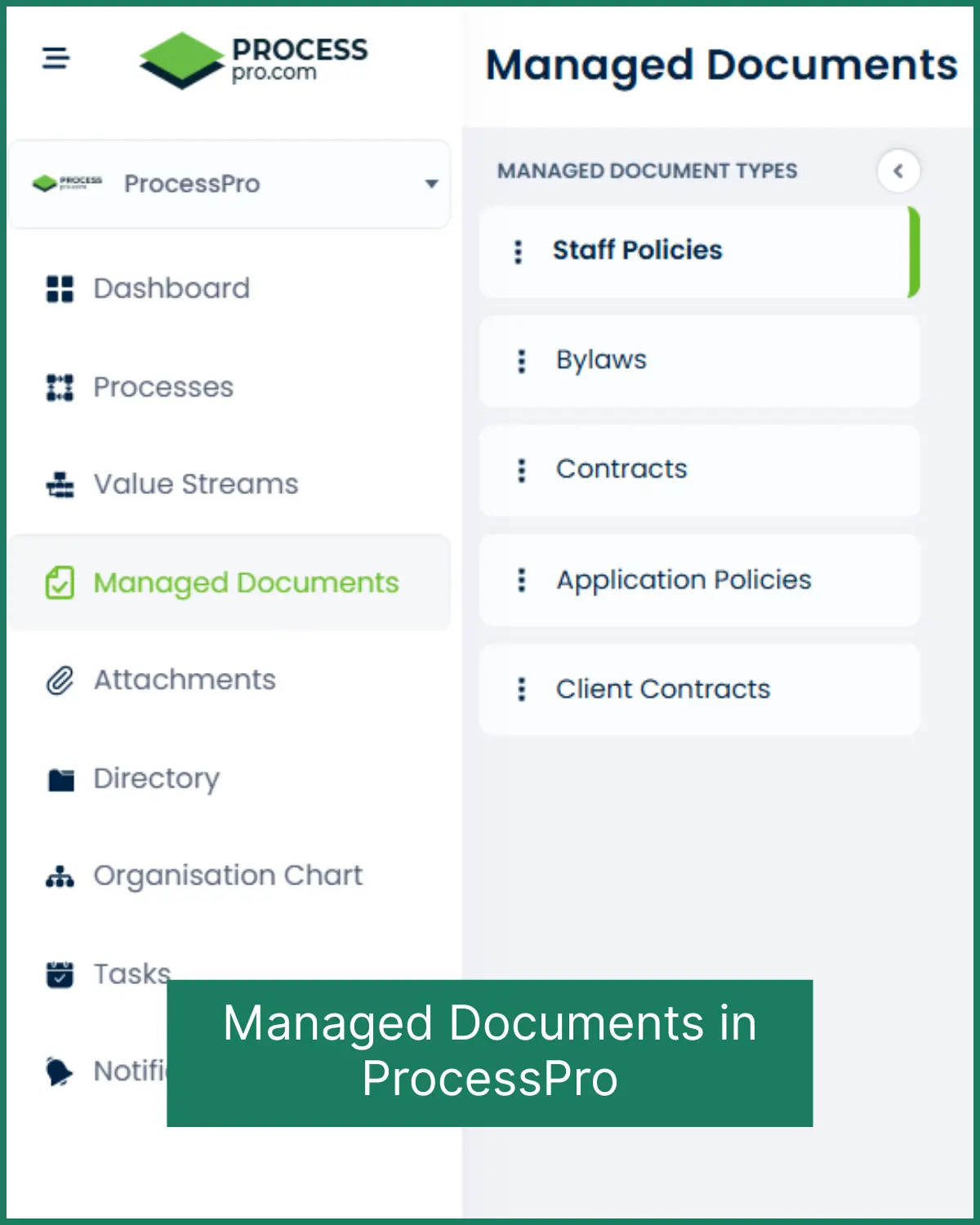Home » Business process documentation software built for clarity
Collaboration and Knowledge Management
Business process documentation software built for clarity
Business process documentation software is becoming essential for teams that want to avoid costly mistakes and keep operations consistent. According to McKinsey, employees spend an average of 1.8 hours every day searching for information, adding up to nearly a full day of lost productivity each week. When documents are hard to find, out of date, or stored in the wrong place, work slows down and risk increases.
This blog will show you what business process documentation software is, why your current system might be falling short, and how ProcessPro helps you manage and control your most important documents in one place.

What is business process documentation software?
Business process documentation software helps you manage the documents that define how your organization runs. This includes policies, procedures, contracts, bylaws, and other important resources.
When documents are stored in random folders or left out of date, teams lose clarity. Mistakes increase. Compliance becomes harder.
ProcessPro is a centralized platform that brings structure, version control, and governance to your business documents, while keeping everything connected to the processes they support.
Why process documentation alone isn’t enough
Writing a procedure is one thing. Making sure the right people can find, trust, and use it is another.
Most companies still store documents in shared drives or email attachments. These methods are prone to version confusion, poor visibility, and missed updates.
Without a clear system, you risk:
- Using outdated instructions
- Slowing down onboarding
- Failing audits
- Reinventing the same process again and again
Poor knowledge sharing doesn’t just slow down work, it can lead to costly mistakes and inconsistent results across teams.
Stronger business process management practices give teams the structure they need to avoid these issues and work with greater clarity.
That’s why leading teams turn to purpose-built documentation software.
Want to see how ProcessPro helps teams manage documents with clarity and control?
Book a Demo and explore how it works.
What to look for in business process documentation software
When evaluating tools, focus on features that support structured, controlled knowledge management:
- Central access to all key documents
- Role-based permissions for editing and viewing
- Draft, published, overdue, and offline status tracking
- Version control and document history
- Review cycles and publishing processes
- Ability to connect documents to processes and value streams
- Clearly assigned ownership and stakeholder roles
These features move your documentation from something people forget to something they rely on daily.
Key takeaways
• Shared drives and basic tools often fall short when managing process documentation
• Business process documentation software brings structure, control, and visibility
• The right platform should offer version control, role-based access, and clear ownership
• Centralizing your documentation helps teams work with consistency and confidence
What are managed documents in ProcessPro?
Managed Documents is a built-in feature of ProcessPro. It gives you a reliable system for creating, storing, and managing policies, contracts, and other essential business documents.
Documents can be:
- Assigned to owners and stakeholders
- Linked to processes and value streams
- Set to private or public
- Reviewed and published with structured approval
- Tracked through version history
- Restored or replaced without losing structure
It’s not just storage, it’s governance.
Pro tip
Use document associations to create a living network of knowledge. Link policies to the processes they support, or connect related documents like contracts and procedures. This makes it easier for teams to find what they need—right when they need it.
How managed documents work
ProcessPro’s Managed Documents feature is designed to give you complete control over how documents are created, accessed, reviewed, and maintained, without the complexity.
Centralized access and permissions
Keep all key documents in one place. Control access based on user roles. Only stakeholders and administrators can view drafts or make edits. Filters and sort tools make it easy to find what you need.
Link documents to processes
You can associate a document with one or more business processes or value streams. You can also link one managed document to another, for example, connecting a policy to a contract.
Linking documents to the processes they support helps your team stay aligned and reduces confusion. If you’re looking for a clear way to visualize those processes, our guide to business process mapping breaks down the steps to do it right.
Publishing, reviews, and feedback
Use built-in tools to:
- Request publication
- Confirm reviews
- Track acknowledgements
- Collect stakeholder feedback
- Monitor document status and deadlines
- Restore older versions as needed
All changes are logged for full transparency.

Benefits of using ProcessPro as your business process documentation software
Using ProcessPro to manage business process documentation gives your team more than just storage. It gives you control, structure, and visibility.
Here are some of the key benefits:
- One source of truth – No more wondering which version is the right one
- Faster onboarding – New team members have clear documents from day one
- Better compliance – Review cycles and version history support audits
- Fewer mistakes – People can find and follow accurate documentation
- Clear accountability – Owners and stakeholders are clearly defined
- Improved knowledge sharing – Teams stay aligned across departments and time zones
Managed Documents turn documentation from an afterthought into a reliable part of daily operations.
Key takeaways
• ProcessPro makes it easy to organize, manage, and update important documents
• Managed Documents support structured publishing, feedback, and associations
• Clear roles, audit trails, and centralized access reduce errors and improve trust
• Teams save time and reduce risk by working from a single source of truth
Examples of managed documents in action
Different teams use ProcessPro’s Managed Documents in different ways. Here are a few examples:
HR teams
- Maintain up-to-date onboarding checklists
- Store company policies in one place
- Set review cycles for HR procedures
Finance teams
- Control access to approval guidelines
- Link financial policies to associated contracts
- Track updates to reimbursement procedures
Compliance teams
- Create audit-ready documentation
- Keep regulatory documents current
- Assign review responsibilities across departments
Comparison: ProcessPro vs traditional document tools
To understand the value of using business process documentation software like ProcessPro, it helps to see how it compares to the tools many teams still rely on.
| Feature | Shared Drives | Document Repositories | ProcessPro |
|---|---|---|---|
| Centralized Access | ✔️ | ✔️ | ✔️ |
| Version Control | ❌ | ⚠️ | ✔️ |
| Role-Based Visibility | ❌ | ⚠️ | ✔️ |
| Document Status (Draft, Published, etc.) | ❌ | ❌ | ✔️ |
| Links to Processes | ❌ | ❌ | ✔️ |
| Structured Review Cycles | ❌ | ❌ | ✔️ |
| Ownership & Governance | ⚠️ | ⚠️ | ✔️ |
ProcessPro is purpose-built for business process documentation. It’s not just about where documents live. It’s about how they’re managed.
Best practices for managing process documentation
Even with the right software, your team needs the right habits. Here are some best practices to keep your documentation useful and current:
- Assign clear ownership – Every document should have someone responsible for it
- Use review cycles – Regularly check documents for accuracy and relevance
- Tag documents properly – Make them easier to find and organize
- Avoid drafts sitting idle – Publish once ready, or archive if no longer needed
- Connect documents to processes – So people know where to find them when they need them
The more structure you apply, the more reliable your documentation becomes.
Get started with ProcessPro
Managing policies, procedures, and other key documents doesn’t have to be messy or manual. Business process documentation software gives your team a smarter way to stay organized, reduce risk, and keep everyone aligned.
With ProcessPro, you get a centralized system to manage, review, and control your business-critical documents, all connected to the processes they support. From version history and role-based access to document associations and structured approvals, everything your team needs is in one place.
The results you’ll see with ProcessPro's business process documentation software
A centralized hub that replaces scattered files and disconnected folders
Current, reviewed, and approved documents your team can trust
Easier compliance and audits with clear ownership and version control
HR, finance, and compliance teams that save time and reduce risk
A culture of knowledge sharing and alignment instead of silos
If you’re ready to reduce confusion and build a stronger foundation for your processes, book a demo and see how ProcessPro can support your team.
Frequently asked questions about business process documentation software
1. What is the best business process documentation software?
The best software depends on your needs. Some tools focus on visuals or templates, while others offer more control and structure. ProcessPro is built for teams that need centralized access, version control, and governance across policies, procedures, and other key documents.
2. Is there a free version of business process documentation software?
Some tools offer free versions for diagramming. However, most free options don’t include features like role-based access, document status tracking, or linked documents. These are essential for larger teams managing real business risk.
3. Can I use Microsoft tools for process documentation?
Microsoft Word, Excel, and SharePoint are often used to store documentation, but they lack the governance features found in purpose-built platforms. ProcessPro offers more control, visibility, and connections to business processes, making it easier to manage documents at scale.
4. What types of documents can I manage with ProcessPro?
ProcessPro supports a wide range of business documents, including policies, procedures, contracts, and bylaws. You can also create custom document types and link them to processes or other documents for better structure and traceability.
5. Are there templates for process documentation?
Many platforms offer downloadable templates, but templates alone don’t ensure consistency. ProcessPro provides a structured environment where templates, review cycles, ownership, and approval are all managed in one place.

James Ross
Founder & CEO. James is passionate about all thing Process Mapping and sharing his wealth of experience with his valued clients. He works closely with his teams to ensure that ProcessPro solves real everyday process mapping problems.
Share this article
